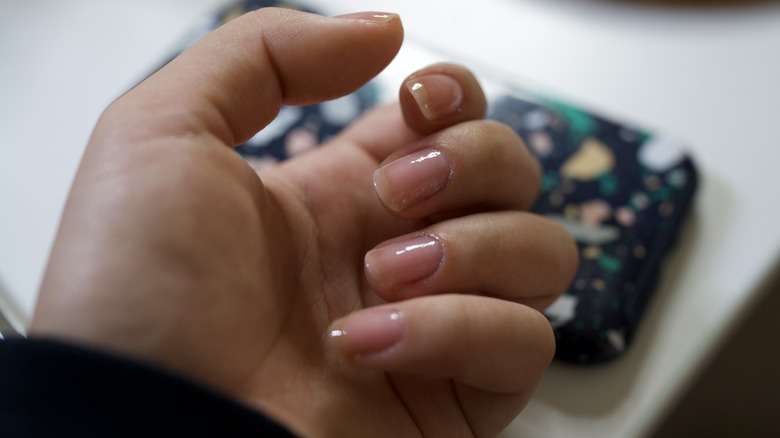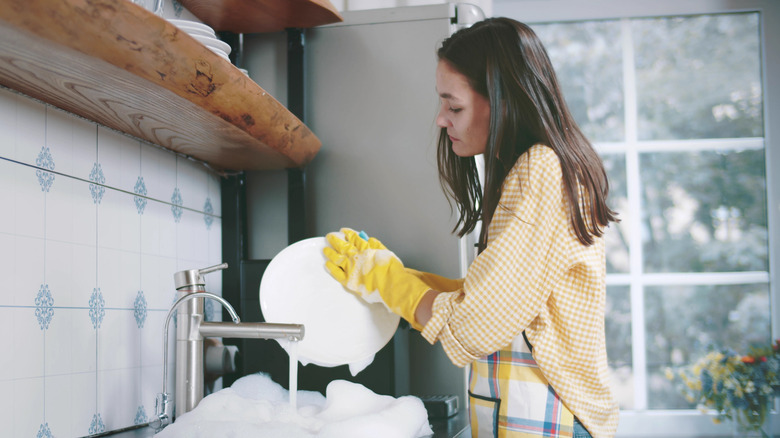Why Your Nails Are Peeling, And How To Fix Them
Notice that your nails are peeling? You're not alone. "This is something that you definitely see in clinics all the time," Dr. Paul Curtiss, a board-certified dermatologist, admitted to Good Housekeeping. In fact, a 2011 study found that as many as 20% of people in the US could be experiencing brittle nails, which often results in peeling.
There are several reasons why this could be happening. One of which could be due to nail trauma, such as harsh manicures (particularly things like hard gel, which can be difficult to remove) or trapping the finger. Other reasons your nails may be peeling? Picking off nail polish, wearing falsies like gel extensions or acrylics as they can weaken the nails, or even having your hands in water for prolonged amounts of time. That's because too much contact with water can actually cause nails to dry out and turn brittle. Using too many harsh soaps or chemicals on the fingers can do the same.
You may find there's a more serious medical reason for why your nails are peeling. Having a vitamin deficiency, and being low on iron in particular, may be the cause. You'll usually know if this is the case because both the fingernails and toenails will peel. Board-certified dermatologist Dr. Lisa Nyanda-Manalo, also noted to Good Housekeeping that thyroid disease or kidney problems could also be to blame. But don't fret if you're dealing with peeling nails, because there are a range of fixes.
There are several ways to help peeling nails
If you're confident your nails are peeling due to a vitamin deficiency, one of the quickest and easiest ways to address the issue is to take supplements. It's a good idea to see your doctor or a nutritionist first though, to ensure you're getting exactly what you need. Similarly, if you're worried kidney or thyroid issues may be behind the peeling, it's equally important to speak to a medical professional to get to the cause and get tailored advice.
If you're certain there's no medical reason for your nails peeling, there are a few other ways to help kickstart repair. Avoiding picking at them and peeling them further is one of the most obvious ways, as is making sure you always apply a base coat and a top coat when getting a manicure. A base coat will help nourish the nails and cover any cracks that could turn into peeling layers. Equally, a top coat can help essentially seal the nail and protect any existing peels from getting snagged and being made worse. There are plenty of nail strengtheners on the market to help bring strength and nourishment back to your talons. However, if your nails are peeling badly, you may want to skip getting a manicure altogether for a few weeks to give your nails a break, especially if you get gel manicures or extensions.
There are ways to prevent peeling nails in the future, too
There are a few things you can do to not only help your peeling nails but stop new issues from occurring, too. Try wearing gloves when your nails come into contact with a lot of water, such as when you're doing the dishes, and make sure your hands and nails are regularly moisturized. One way to do that is to keep up with your nail oil routine. A good nail and hand care routine can also include a little exfoliation, board-certified dermatologist Dr. Dana Stern told Prevention. Just make sure you don't over-exfoliate the skin, as that can cause serious issues in itself.
Another method to keep the nails moisturized and less likely to peel? Nail slugging, which entails slugging the whole nail in cuticle oil and sealing it in. It's also important to buff and file your nails the right way so that you're not encouraging peeling. According to Healthline, the best way to do this is to only buff the nail in one direction. It's a misconception that you should go back and forth over your nail, as this could actually end up making the nail weaker and more prone to peeling.


